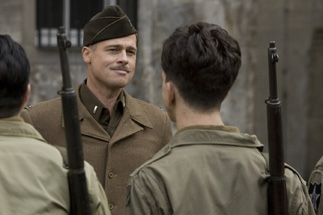|
|
Movie Review: Inglourious BasterdsBy Matthew HuntleyAugust 31, 2009
During the opening massacre, a young Jewish woman (Melanie Laurent) escapes and flees to Paris, where she takes over her family's cinema. Landa sees her run away but lets her live, probably because he thinks she's something worth hunting at a later time. In Paris, the young woman, named Shosanna, catches the eye of a boyish Nazi soldier (Daniel Brühl), who's become a local celebrity and certified war hero for killing hundreds of enemy soldiers from a crow's nest all by himself. Joseph Goebbels (Sylvester Groth) was so impressed by the boy's statistics, he had a propaganda film made about him, which the Nazis want to premiere at Shosanna's theater. She accepts the offer and thinks it a perfect opportunity to kill all the heads of the Party, including the Fuehrer himself (Martin Wuttke). The British have also learned of the premiere and enlist the Basterds and a German actress (Diane Kruger), working as a double agent, to carry out an assassination. For a two and a half-hour film, it's ironic how few scenes there actually are in Inglourious Basterds. Each scene just happens to be longer than usual, but not necessarily too long. Sure, there are times when Tarantino tries our patience (once again, he shows he can be too in love with his own dialogue and character observation), but he hits the majority of his marks. The film negotiates with its extended moments by building tension where necessary as a way to keep things moving. Tarantino employs a variety of devices to accomplish this, including cleverly staged crane shots; off-screen dialogue from another character; close-ups of peculiar images, like food; and subtle looks from characters trying to resist exposure. Inglourious Basterds has a lot of hard suspense, but it also has its fair share of humor and sensationalism, thanks mostly to the anachronistic Basterds gang. They possess a 1970s gangster sensibility and Tarantino moves them to the rhythms of Spaghetti Western music. And it just wouldn't be Tarantino without a couple freeze frames, animated text and graphic novel-like interludes to introduce the more colorful characters. On paper, these more outrageous scenes shouldn't gel with the stern and serious backdrop of World War II, but Tarantino makes them fit. It also works because, frankly, we haven't seen this style done before. I have a feeling many viewers will not appreciate both sides of this movie — they'll either like the austere drama OR the exploitative, sensational bloodbath, but probably not both. Their guts will tell them Tarantino should have gone one way or the other. But luckily Tarantino is no ordinary director; he takes chances and gambles with his narratives. He directs with his instincts instead of abiding by genre rules. What genre would Inglourious Basterds fall into, anyway? Like all the great Tarantino movies, it's a mix, and each one is taken in a radical direction that makes it hard to categorize. Usually, that's the sign of something special.
|

|
|
|

|
Thursday, October 31, 2024
© 2024 Box Office Prophets, a division of One Of Us, Inc.


